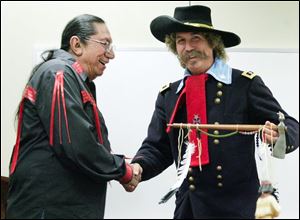
'Custer' surprises Perrysburg museum meeting
10/8/2008
Ernie LaPointe, great-grandson of Sitting Bull, greets Steve Alexander, in the guise of Lt. Col. George Armstrong Custer, at the annual meeting of the Perrysburg Area Historic Museum.
Supporters of the Perrysburg Area Historic Museum had a big surprise at their annual meeting at Fort Meigs.
They knew the speaker at last week's get-together would be Ernie LaPointe, the great-grandson of Sitting Bull, the legendary Sioux who prepared warriors for the Battle of the Little Big Horn in 1876.
What they didn't know was that a surprise guest would make an appearance - in the form of Lt. Col. George Armstrong Custer himself.
But this was no last stand.
"Custer" carried a peace pipe, and he and Mr. LaPointe embraced warmly, to applause from the 50 people in the audience.
The two men are friends. In reality, Custer was Steve Alexander of Monroe, who bills himself as the "foremost Custer living historian."
Dressed in the blue uniform of the 7th Cavalry, he bore more than a passing resemblance to the real Custer, who remains one of the most controversial characters in U.S. military history.
Mr. Alexander was in Perrysburg to promote the Custer Celebration, a historical observance that ends Saturday and held primarily in Monroe.
Custer was born in Harrison County, Ohio, but made Monroe his hometown.
Mr. LaPointe, 60, has been in Monroe this week as a guest and participant.
He is a lineal descendant of Sitting Bull on his mother's side, and travels across the country setting the record straight about his famous ancestor.
Much of the history written about Sitting Bull is bunk, he told his Perrysburg audience.
"It's always an honor to me when I get invited to speak about my ancestor," he said. "It's very difficult to be related to somebody like Sitting Bull. In all the books and movies about him, none of the authors have ever come to speak with us."
Mr. LaPointe said most of the popular history of Sitting Bull comes from the biography Sitting Bull: Champion of the Sioux, which he described as "all hearsay" that misrepresents the chief and his life.
Sitting Bull is known as a warrior, Mr. LaPointe said, but this was not the largest part of his life.
The chief became a Sioux holy man in his early 20s, a role that required him to be an expert in the religious rituals and beliefs of the tribe. He was not a medicine man, but he knew how to use herbs in healing.
Mr. LaPointe recalled that as a boy in the 1950s, he spoke to Sioux veterans of the Little Big Horn who had been teenagers at the time of the battle.
Mr. LaPointe lives in Lead, S.D. He was born in the state's Pine Ridge Indian Reservation, and grew up in Rapid City. He is an Army veteran of the Vietnam War who also was stationed in South Korea, Turkey, Germany, and in the United States during his six years in the military.
In 2003, he said, the Smithsonian Institution asked him to authenticate a collection of artifacts it owned that supposedly had belonged to Sitting Bull.
He said he determined that only an 1866 Winchester rifle, leggings, a lock of hair, and a pair of moccasins made by one of Sitting Bull's wives were genuine.